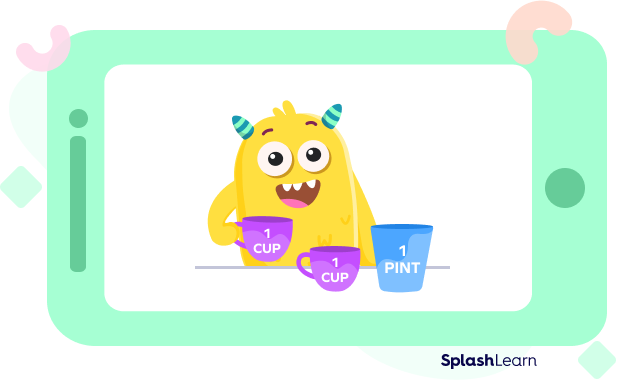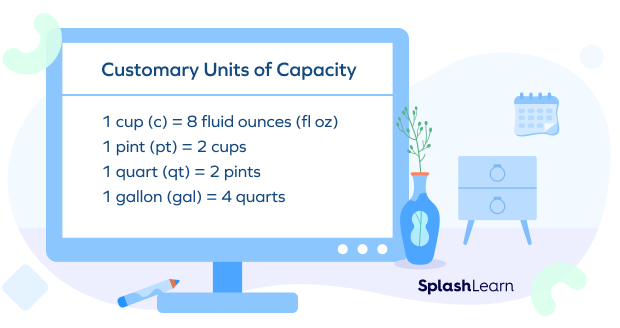What is Capacity in Math?
Have you observed that when you fill water in a pan or a bottle, there is only a certain amount of water you can fill in them? All the sodas and chocolate syrups have a maximum amount mentioned on their containers. This certain amount that the pan, bottle, or any other container can hold is called capacity. In mathematics, capacity is defined as the maximum quantity a container can hold when full.

There are two types of capacity measurement: metric measurement and customary measurement.
 Begin here
Begin here
Metric Measurement
The standard units to measure capacity are liters and milliliters.
Milliliter (ml): Milliliter is denoted by the letters ml. A milliliter is a unit to measure very small quantities of liquids like cough syrup.
Liter (l): Liter is denoted by the letter l. A liter measures liquids like juice, milk, water, and so on.
The units’ milliliter (ml) and liter (l) are related:
One liter is equal to a thousand milliliters.
1l = 1000 ml or 1000 ml = 1l
Related Worksheets
Customary Measurement
Customary measurement refers to gallons, quarts, pints, cups, and fluid ounces. This is US Standard Unit (English Unit or Customary Unit).

Fluid Ounce: A fluid ounce is a unit used to measure the volume of liquids. It is commonly abbreviated as fl. oz.
Cup: A cup is a unit of volume measurement equal to 16 tablespoons. A US cup is about 237 ml. It is usually used for drinking beverages like coffee or tea.
Pint: A pint is equal to 2 cups. A US pint is about 473 ml. We express the capacity of juice jars in pints.
Quart: A quart (qt) is the same as 2 pints. The capacity of milk cartons is expressed in quarts.
Gallon: A gallon (gal) is the largest liquid measurement. It is the same as 4 quarts. The capacity of fuel tanks is expressed in gallons.

Solved Examples
Example 1. Susie bought 4 liters of orange juice. She wants to convert this quantity into milliliters. Can you help her?
Solution:
We know that 1l = 1000 ml
So, 4l = 4 ✕ 1000 ml = 4000 ml
Therefore, the quantity of orange juice bought by Susie in milliliters is 4000 ml.
Example 2. Ray bought 6 gallons of paint to decorate his house. Help him convert the quantity of paint to quarts.
Solution:
We know that 1 gallon = 4 quarts
So, 6 gallons = 6 ✕ 4 quarts = 24 quarts
Therefore, the quantity of paint bought by Ray is 24 quarts.
Example 3. Danny drank 2 cups of an energy drink on Monday. How much quantity is that in fluid ounces?
Solution:
We know that 1 cup = 8 fluid ounces
So, 2 cups = 2 ✕ 8 fluid ounces = 16 fluid ounces
Therefore, the quantity of energy drink Danny drank was 16 fluid ounces.
Practice Problems
Capacity in Math – Definition with Examples
Jack made 4 pints of lemonade. If he divided it into an equal number of paper cups, how many paper cups would he need?
A pint is equal to 2 cups.
So, 4 pints = 4 ✕ 2 cups = 8 cups.
Convert 4.5 liters into milliliters.
We know that 1 l = 1000 ml
So, 4.5 l = 4.5 ✕ 1000 ml = 4500 ml
Convert 12 cups to pints.
We know that 1 pint is equal to 2 cups.
So, 1 cup is half of a pint.
So, 6 cups in pints = 12 ÷ 2 = 6 pints.
Aisha’s mom poured 3 quarts of chocolate milk into an equal number of cups for children at a sleepover. How many cups did she use?
A quart is equal to 4 cups. So, 3 quarts = 3 ✕ 4 cups = 12 cups.
Frequently Asked Questions
What does capacity measure?
Capacity measures the maximum amount of a liquid that a container can hold when full.
What are the U.S. customary capacity measurement units?
The U.S. customary capacity or volume measurement units are ounces, cups, pints, quarts, and gallons.
What is the standard unit of capacity?
A liter is the standard unit of capacity, and the smaller unit of capacity is a milliliter. In short, a liter is written as ‘l’ and milliliter as ‘ml.’ Liter (l) and milliliter (ml) are related to each other as 1 liter = 1000 milliliter (1 l = 1000 ml).















